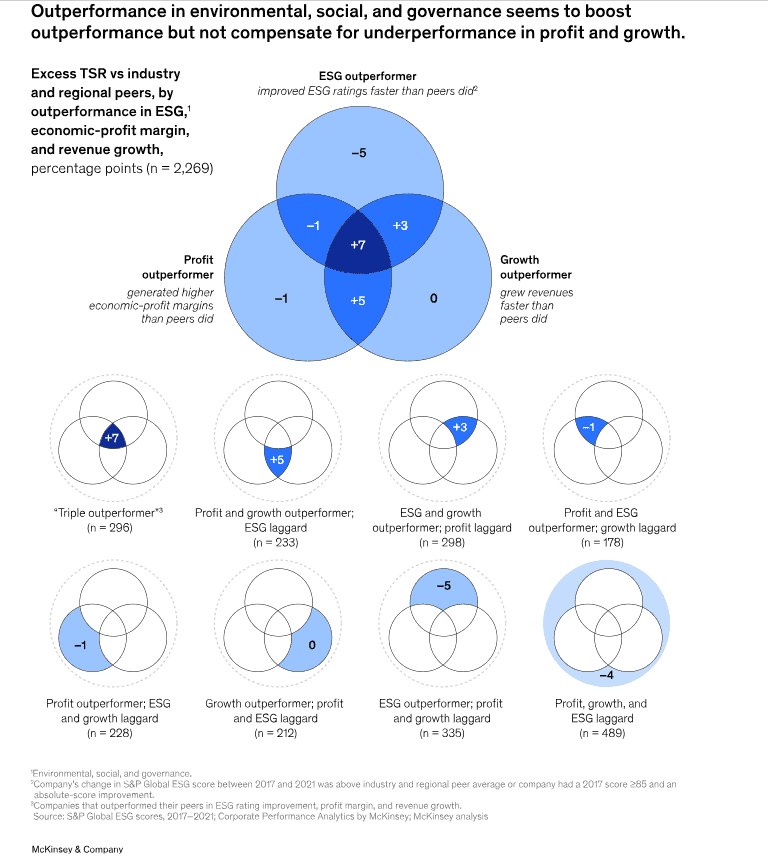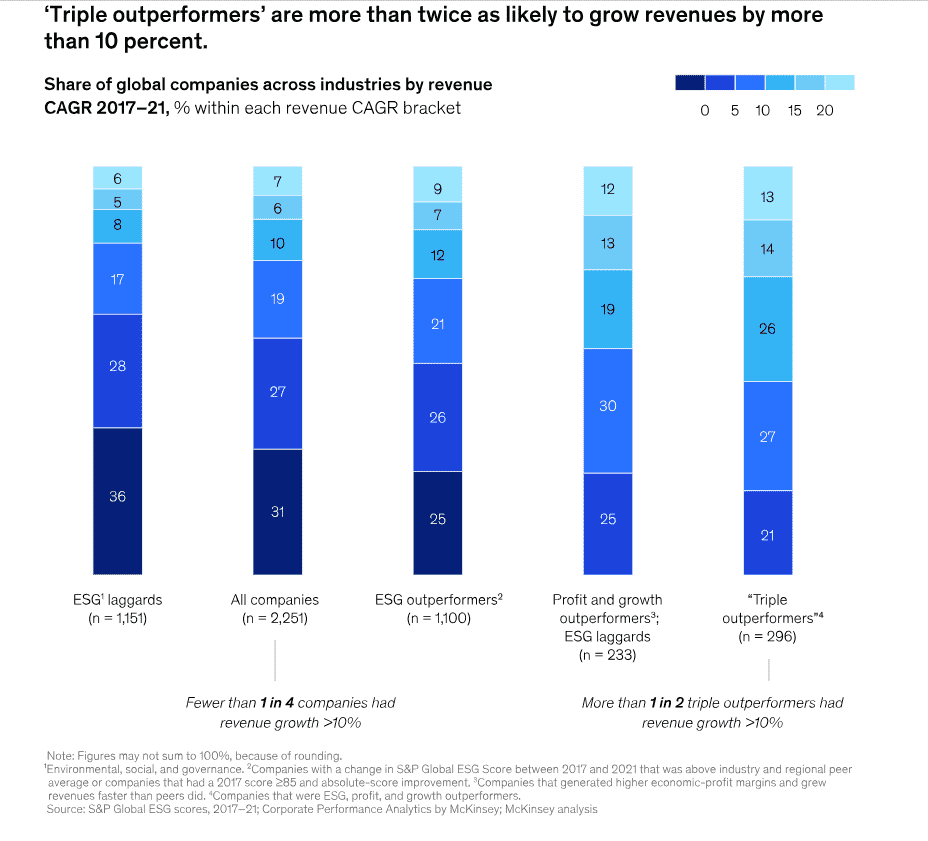Revenue growth is good. Profitable growth is better. Profitable growth that advances ESG priorities is best. Here’s how outperformers who actively choose growth deliver the growth trifecta.
Consistent and profitable growth has been hard to achieve since the global financial crisis, making it critical for companies to explicitly choose growth in their mindsets, pathways, and execution capabilities.1 Many executives believe making that growth sustainable and inclusive requires inscrutable trade-offs, forgoing revenue and profit for the sake of society and the planet.2 That is not always the case. Our new analysis indicates financially successful companies that integrate environmental, social, and corporate governance (ESG) priorities into their growth strategies outperform their peers—provided they also outperform on the fundamentals. The message is clear: not only can you do well while doing good—you can do better.
We looked at TSR, financial performance, and ESG ratings of 2,269 public companies, separating them into industry outperformers and underperformers along the axes of ESG scores, annualized revenue growth, and economic profit (see sidebar “Our methodology”). The analysis shows that companies that achieve better growth and profitability than their peers while improving sustainability and ESG outgrow their peers and exceed them in shareholder returns.3 These “triple outperformers” delivered 2 percentage points of annual TSR above companies that only outperformed on financial metrics (and 7 percentage points above the rest of the dataset), suggesting that a strong ESG commitment adds additional shareholder value for companies that also exceed their peers in growth and profitability (Exhibit 1).4

We based our research on ratings data from S&P Capital IQ and S&P Global ESG. We limited the analyses to the period between the start of 2017 and the end of 2021. While such a short period entails limitations in TSR analysis, we chose it because little ESG data is available for earlier years, and rating agencies re-rate companies for up to five years back. We examined the performance of global companies for which we could obtain the complete data set—revenue, economic profit, TSR, and ESG ratings—for every year in that time frame.
For each company, we calculated excess revenue CAGR, excess economic profit margins, excess TSR, and excess ESG rating improvement (measured as ESG rating improvement less regional and industry peer median). We considered as ESG outperformers both companies with excess ESG rating improvement and those with ESG ratings above 85 in the first year of the analysis that further improved their rating during the period under study. The analyses relied on median values to guard against the impact of outliers. Values presented in the article (excess TSR, revenues, and economic profit) are annual.
We separated the total set into outperformers and underperformers in each region and approximately 20 industries along the axes of ESG performance, revenue growth, and economic profit. Of the total sample of 2,269 companies, 296 companies were categorized as “triple outperformers,” while 233 companies outperformed their peers in growth and economic profit but lagged in ESG.
We consider ESG ratings the best available measures to assess companies’ ESG performance. However, correlating ESG action with market and balance sheet performance entails limitations today, including data scarcity, especially prior to 2017; divergent ESG rating metrics that affect the correlation between scores; and fixed 0-to-100 scales for ratings.
Importantly, excelling at ESG does not compensate for poor growth and profitability. For example, growth and profit laggards that only outperformed on ESG measures underperformed peers by five percentage points of TSR. In other words, ESG is not a panacea—it won’t save an underperformer with a flawed strategy. Additionally, the analysis does not imply that capital markets give valuation premiums to triple outperformers, only that those companies outperformed on financial metrics.
Revenue + Economic Profit + ESG Progress = Outsize Returns
Strong growth has been elusive over the past 15 years, with the world’s largest companies growing at half the rate they did before 2008.5 Between 2017 and 2021, fewer than one in four companies in our sample achieved more than 10 percent revenue growth annually. Triple outperformers fared much better, however, as more than half grew by 10 percent or more (Exhibit 2).

Triple outperformers increased their revenues at a median rate of 11 percent per year—1.4 percentage points higher than the median achieved by profitable growth outperformers that lagged on ESG. Triple outperformers also exceeded profitable growth outperformers in median excess TSR by 2.5 percentage points.
The timeless principles of shareholder value creation hold: ESG efforts ultimately have to show up in financial performance to create outsize returns. The importance of actively choosing to grow by adopting the right mindset, strategy, and capabilities also continues to be essential: If you can grow profitably as a sustainability leader, the market will reward you for this growth. A recent McKinsey analysis, for example, shows that chemical players with low-carbon product portfolios or high exposure to end markets supporting sustainability grew their shareholder returns at more than double the rate of sustainability laggards between 2016 and 2021.6 Similarly, mining players tapping into the growth opportunities associated with rising lithium demand from green technologies are getting a positive market reception.
With increased uncertainty and stock markets declining between January and June 2022, we expected that gains accrued by ESG leaders might have eroded due to short-term performance pressures. While the full sample’s excess TSR decreased during the recent downturn, we found that markets continued to value ESG leadership. Outperformers in revenue growth alone during the 2017–21 period saw their excess TSR advantage over peers drop by one percentage point, to 3 percent, in the 2017 to June 2022 time frame. For profitable growth outperformers, their 6 percent edge over peers in 2017–21 decreased to 4 percent in the 2017 to June 2022 period. Triple outperformers’ excess TSR of 7 percent, meanwhile, declined by two percentage points when we extended the analysis to the end of June 2022, but these companies still delivered higher returns than either revenue outperformers or profitable growth outperformers.
It’s important to note that not all industries registered shareholder returns correlated with ESG-rating improvements during our study’s time frame, and some of the gains may be affected by the current downturn (see sidebar “Impact of the recent market correction”). The biggest shareholder gains accrued to triple outperformers in basic materials, advanced electronics, and the financial sector, likely due to shifting consumer preferences that supported “green premiums” and lowered risk around regulations and carbon-related costs. On the other hand, high tech and retail have not been able to realize benefits from strong ESG rating improvements—yet. Industry dynamics and the COVID-19 crisis (producing growth for high tech but a slump for retail) might have outweighed ESG effects in these sectors. We believe, however, that the ESG performance bar is rising rapidly across sectors and regions. Furthermore, merely keeping pace with your industry does not deliver market premiums—investors reward companies that improve their ESG ratings faster than peers in addition to outperforming on other dimensions.
How to Make the Growth Triple Play
So how do triple growth outperformers manage that feat? They tend to be guided by five principles: integrating growth, profitability, and ESG into the core strategy; innovating ESG offerings to drive value creation; using M&A to rapidly capture ESG growth pockets; tracking and reporting ESG and related data transparently; and embedding strategic priorities in the organizational DNA.
Integrate growth, profitability, and ESG into the core strategy. Top performers don’t pursue ESG-related initiatives on the side but integrate them into the overarching corporate strategy alongside growth and profitability. Consider the example of a metals and mining triple outperformer that has focused its strategy and investments on decarbonization as a way to fulfill all three objectives. The company divested its coal-based business and shifted toward materials supporting the energy transition. To raise top-line growth, it set up a ring-fenced budget for investments in green aluminum, green steel, carbon-capture solutions, and other fast-growing markets. In parallel, it undertook multiple initiatives on the social dimension aimed at reducing the risk of regulatory and legal interventions while improving employee productivity. For example, it implemented a plan to create a safer, more inclusive work environment and addressed its local impact through agreements with Indigenous people and local communities.
Innovate ESG offerings to drive value creation. Triple outperformers often operate on the cutting edge of innovation, both in what they do and how they do it. Many focus their innovation efforts primarily on top-line growth by developing offerings to better meet customer needs—and, where possible, serve emerging demand grounded in ESG.
That can involve creating solutions for business customers to help those clients meet their own ESG-related customer or regulatory needs. One European transport and logistics provider, for example, turned to innovation to help it capture the ESG lead in its industry as the topic was gaining stakeholder attention. It opted to focus on helping its customers reduce the carbon footprint in their supply chains. The company created an innovation hub to guide global initiatives and set up a technology trend tracking mechanism to stay abreast of emerging technologies. It is also collaborating with external sustainability, digitization, and innovation experts to develop solutions customized to its customers’ supply chain challenges. This investment has produced new premium-priced offerings for carbon reporting and offsetting, sustainable fuel, and supply chain design and optimization, significantly boosting its revenue. As a result, the company has translated its industry first-mover advantage on ESG into 20 percent higher annual revenue growth than its peers while also realizing 20 percent annualized excess TSR since 2017.
Use M&A to capture profitable ESG growth pockets at an accelerated pace. Programmatic M&A can accelerate companies’ entry into new areas of growth.7 Successful players have tended to look for underserved adjacent growth pockets and allocate ring-fenced funds to capture these opportunities. Many triple outperformers go a step further by integrating ESG criteria alongside existing financial and market criteria into their evaluation of potential adjacencies and M&A target selection.
One multinational cosmetics company, for example, developed a reputation for a high focus on sustainability and inclusion by shifting its asset portfolio toward ESG-oriented offerings. Over a decade, it acquired a dozen innovative firms, adding both luxury brands that offer sustainable, inclusive products and services and expanding into new areas such as women’s health tech. By leveraging synergies between the brands, it captured growth pockets both within its core business and in adjacent segments. In the process, the company’s ESG ratings soared by 39 percentage points during the period of our study, and investors boosted its shareholder returns by 25 percent per year above its industry average.
Report and communicate transparently. We often hear business leaders express frustration that capital markets fail to recognize and reward their companies’ investments in initiatives with longer time horizons, which is often true for ESG-related growth ventures. While there are numerous reasons why that may be the case, rigorous reporting and proactive communication to the investment community of how these initiatives boost value, along with the targets and progress, are critical to gaining those rewards. Communication alone will not drive value, but transparency can accelerate investors’ recognition of future potential. Once a company has set clear and ambitious goals, it needs to continuously demonstrate where the value comes from and show strides on related initiatives—with external validation where possible—for progress to be credible in consumers’ and investors’ minds.
For example, one European software provider created a user-friendly interactive tool that publicly tracks its progress on key ESG metrics alongside its financial performance. The dashboard is particularly robust in tracking the “S,” or social, dimension, which the company has prioritized. For example, the gender ratios of its workforce can be viewed not only by seniority but also by the number of part-time versus full-time workers and permanent versus temporary workers. A multinational automotive technology supplier, meanwhile, continually reinforces the link between its technology and sustainability strategy to external stakeholders, closely tying its sustainability and ESG goals to strategic objectives such as market growth, productivity, and customer satisfaction.
Embed strategic priorities in the organizational DNA. Triple outperformers translate their high-level growth, profitability, and ESG strategies into concrete initiatives that form part of the new corporate strategy. Management teams set out clear responsibilities, performance metrics, and targets and measure them rigorously. They also reallocate their resources toward these new opportunities and ensure that internal processes encourage business leaders to integrate the relevant criteria—including ESG—into their decisions.
For example, a global shipping player that achieved triple outperformance ensured its strategy was fully embedded into the organization. The company set up committees at all levels, from the board of directors to operations, to holistically assess the most metrics, including growth, profitability and ESG. Additionally, the organization linked remuneration to key ESG targets and built partnerships with customers to codevelop new green solutions. Its strong focus on governance has not only helped it to increase revenue growth but also to optimize cost and prepare for potential legislative interventions, such as carbon emissions taxes.
While ESG performance measurement is still evolving, the direction of travel is clear, and action is needed now. Leaders need to take a long-term perspective and have the courage to invest in sustainable and inclusive growth that delivers revenue, economic profit, and shareholder returns.
Rebecca Doherty is a partner in McKinsey’s Bay Area office, Claudia Kampel is an associate partner in the Stuttgart office, Anna Koivuniemi is an alumna of the Amsterdam office, Lucy Pérez is a senior partner in the Boston office, and Werner Rehm is a partner in the New Jersey office.
The authors wish to thank Donatela Bellone, Michael Birshan, Marc Goedhart, Theresa Krause, Lazar Krstic, Karin Löffler, Devesh Mittal, Valdo Nunes, Robin Nuttall, Tido Röder, Sven Smit, Paul Ziesche, and Jill Zucker for their contributions to this article.
The article was first published here.
Photo by Volodymyr Hryshchenko on Unsplash.

 5.0
5.0 





















